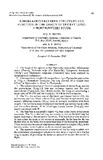| dc.description.abstract | The lungs of five species of bat Pipistrellus pipistrellus, Miniopterus minor (Peters), Tadarida mops (De Blainville), Cynopterus brachyotis (Muller) and Cheiromeles torquatus (Horstield) have been analysed by morphometric techniques. The mean body weight (W) ranged from 5 g in Pipistrellus pipistrellus to 173 g in Cheiromeles torquatus; the lung volume (VL) ranged from 0.3 cm3 in Pipistrellus to 10 cm3 in Cheiromeles. The volume densities or the main components of the bat lung, namely the parenchyma [VV(p,L)] (the gas exchange region) and the non-parenchyma [VV(np,L)], were closely similar, the VV(p,L) constituting a mean value of 84.2% and the VV(np,L) 15.8% in the five species. The VL, the surface area of the blood--gas (tissue) barrier (St), the pulmonary capillary blood volume (Vc), and the total morphometric pulmonary diffusing capacity (DLO2) were all strongly correlated with body weight. The harmonic mean thickness of the blood--gas (tissue) barrier (tau ht) and the surface density of the blood--gas (tissue) barrier [SV(t,p)] were poorly correlated with W. The bats had a remarkably higher VL than either birds or terrestrial mammals. The Vc in the bat lung was similar to that in the bird lung but higher than that of the terrestrial mammals. The bats had a more extensive St than either the birds or the terrestrial mammals. In the bats the tau ht was thicker than in the birds but thinner than that of the terrestrial mammals. These pulmonary structural adaptations culminated in a higher DLO2 in the bat than either in the birds or in the terrestrial mammals. The superior morphometric properties of the bat lung coupled with the established physiological adaptations may help to explain how the bat lung is capable of providing the immense amount of oxygen demanded by flight | |

